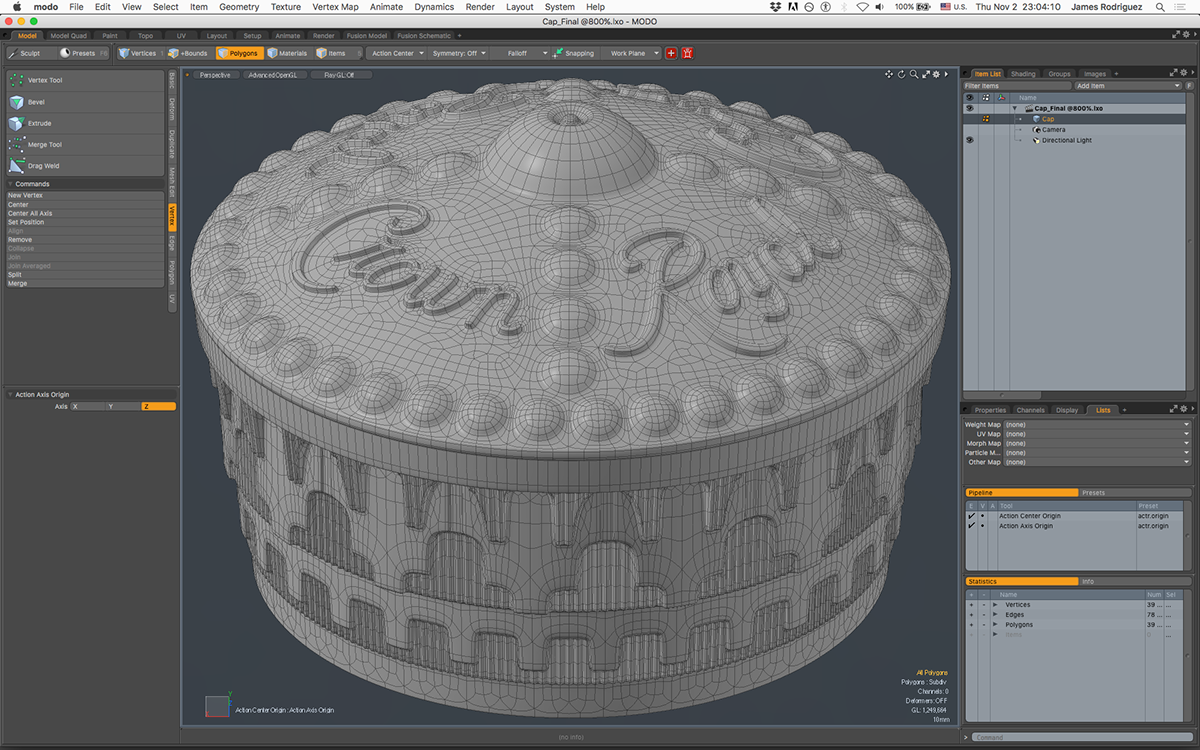Crown Royal 1.75 Liter
Work In Progress, Part 2—Cap Top



Part 2 begins with the Crown Royal logo drawn in Affinity Designer with an orthographic view of the top as a guide. To flatten the perspective of the cap as much as possible I photographed its top and side with a 200 mm lens mounted to my DSLR.
The logo is then imported into Modo as curves, kept flat on a 2D plane and used as a guide for laying down Catmull-Clark subdivided polygons via the Topology Pen Tool. But before the logo is extruded it has to conform to the curved surface by way of a background constraint.






I thought MeshFusion (a plugin now part of Modo) would be the best approach to help model the top of the cap. The plan was to use its finesse with booleans to create fillets for the Crown Royal logo and hemispheres (excluding the texture) and retopologize the result. Displacements will generate said texture covering the knoll (what I call the broad curved surface rising and falling across the diameter).

As expected, the above Catmull-Clark objects used for the Union boolean generated a mesh too dense for my needs. Retopo was always on the agenda. Modo's newer generation retopo tools could have been useful but I'm on Modo 801.


Attempting an airtight MeshFusion output was unsuccessful. At fault was its insistence on changing my Strip settings—which were wide and smooth—to something much narrower and undesired every time I ran the Airtight Auto-Adjust command. This unexpected behavior might have been due to the young MeshFusion v106, the mesh densities and/or my Strip settings. After too long I abandoned the unnecessary airtight procedure. After all, I wasn’t 3D printing this.



Retopologizing the logo began with repurposing the upper half of the original subdivided object. The MeshFusion object played a limited role as the background constraint. For that function I relied on a bare mesh of the knoll to assist in creating the fillets.

Initially, portions of the hemispheres and logo were reconstructed with the aid of the MeshFusion object as a background constraint. However, the reconstruction increasingly became freeform tweaking. If I didn’t have the MeshFusion object I would have devised alternative techniques to arrive at the same finished model.

Completion of the hemispheres and logo was vital before retopologizing the knoll. I used a bare high density mesh which proved more useful as a background constraint than the heavier MeshFusion object—the fillets of which only got in the way.

As a final step it was necessary to lift all of the edges—excluding those of the relief—and translate them back down using the simple knoll mesh as a background constraint. This helped smooth lumps in the topology. The result is better than expected knowing that a displaced texture will occupy the knoll.



Regrettably, for the bulk of retopo, the MeshFusion object saw limited use as a background constraint. Rather, it served mostly as a guide for more traditional subdivision workflows.

Part 1 of this cap—the side—is now joined with the top and interior.

The cap measures about 1.75 inches across, but my working scale is 800%, yielding an object almost 14 inches across. The reason for the enlargement is practical; it can be tricky and inconvenient to model in microns and nanometers. A reciprocal reduction of 12.5% will make it right.

This was my first use of MeshFusion and I count the experience as a learning process in more ways than one. Specifically in the case of modeling the top of this cap, whereas I thought a MeshFusion object would be ideal as a constraint item, it was only moderately useful—and that's being generous. Simply, it was't needed. In hindsight I could have problem solved by traditional means. Even Modo's newer generation retopology advancements might have gone unused because Modo's quintessential modeling methodology seems to be all that was required—in this case.
Next for Part 3: Bottle Start.


